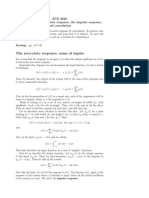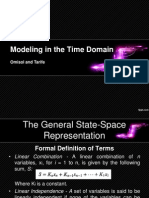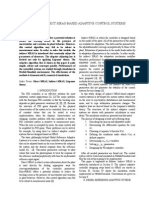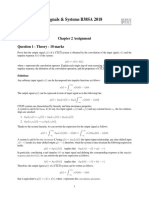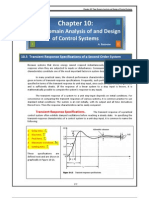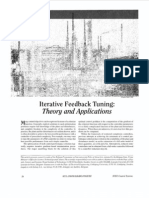Differential Equations Solving For Impulse Response: D y DT + 5 Dy DT + 6y F (T)
Uploaded by
love_accDifferential Equations Solving For Impulse Response: D y DT + 5 Dy DT + 6y F (T)
Uploaded by
love_accDifferential Equations
Linear systems are often described using differential
equations. For example:
d
2
y
dt
2
+5
dy
dt
+6y = f(t)
where f(t) is the input to the system and y(t) is the
output.
We know how to solve for y given a specic input f.
We now cover an alternative approach:
Equation
Differential
convolution
Corresponding
Output
solve
Any input
Impulse response
17
Solving for Impulse Response
We cannot solve for the impulse response directly so
we solve for the step response and then differentiate
it to get the impulse response.
convolution
Corresponding
Output
Equation
Differential
solve
differentiate
Any input
Impulse response
Step response
18
Motivation: Convolution
If we know the response of a linear system to a step
input, we can calculate the impulse response and hence
we can nd the response to any input by convolution.
Suppose we want to know how a cars suspension re-
sponds to lots of different types of road surface.
We measure how the suspension responds to a step
input (or calculate the step response from a theoreti-
cal model of the system).
We can then nd the impulse response and use con-
volution to nd the cars behaviour for any road sur-
face prole.
19
Solving for Step Response
If we want to nd the step response of
dy
dt
+5y = f(t)
where f is the input and y is the output. It would be
nice if we could put f(t) = H(t) and solve. Unfortu-
nately we dont know of a way to do this directly. So
we
1. set f(t) = 1, and solve for just t 0
2. set the boundary condition y(0) = 0 (also y(0) =
0 for second order equations) to imply that f(t)
was zero for all t < 0.
We thus have a complete solution because y = 0 for
t < 0, and we have found y for all t 0.
20
Boundary Condition Justication
Prove that y = 0 at t = 0 by contradiction.
We know that y(t) = 0 for all t < 0. Therefore the
only way for y to equal something other than zero at
t = 0 is if there is a step discontinuity in y at t = 0.
Assume that y has a step of height h at t = 0. If y
has a step discontinuity at t = 0 then
dy
dt
must have
a delta function at t = 0.
So we have:
f(t) is a step function so |f(t)| 1 for all t.
|y| h at t = 0.
dy
dt
at t = 0.
Which violates the original equation at t = 0.
dy
dt
= f(t) 5y
As the RHS is nite but the LHS is innite. Therefore
y must be continuous at t = 0, and we can use the
initial condition y(0) = 0.
21
Step Response Example
Step 1: set f(t) = 1, and solve for just t 0.
dy
dt
+5y = 1
Complimentary function: y +5y = 0 y = Ae
5t
Particular Integral: try y = (a const) y =
1
5
General Solution: y = Ae
5t
+
1
5
Step 2: set the boundary condition y = 0 at t = 0
y(0) = 0 A+
1
5
= 0 A =
1
5
So step response is y(t) =
1
5
_
1 e
5t
_
for t 0.
22
Step Impulse Response
Impulse
Response
g(t)
Step
differentiate
integrate
Response
Step response is y(t) =
1
5
_
1 e
5t
_
for t 0.
Impulse response g(t) is given by:
g(t) =
_
_
0, t < 0
d
dt
_
1
5
_
1 e
5t
_
_
= e
5t
, t 0
23
Find the Impulse Response
d
2
y
dt
2
+13
dy
dt
+12y = f(t)
1. Find the General Solution with f(t) = 1
Complimentary function is y = Ae
12t
+Be
t
Particular integral is y =
1
12
General solution is y =
1
12
+Ae
12t
+Be
t
2. Set boundary conditions y(0) = y(0) = 0 to get
the step response.
1
12
+A +B = 0
12A B = 0
A =
1
132
and B =
1
11
Thus Step Response is y =
1
12
+
e
12t
132
e
t
11
3. Differentiate the step response to get the impulse
response.
g(t) =
dy
dt
=
e
t
e
12t
11
, (t > 0)
24
Using the Impulse Response
If we have a system input composed of impulses,
f(t) = 3(t 1) +4(t 2)
we can nd the corresponding system output using
superposition.
y(t) = 3g(t 1) +4g(t 2)
= 3
_
_
e
(t1)
e
12(t1)
11
_
_
+4
_
_
e
(t2)
e
12(t2)
11
_
_
25
More General Input
Suppose our input is composed of lots of delta func-
tions:
f(t) =
n
p
n
(t q
n
)
Then the corresponding system output will be
y(t) =
n
p
n
g(t q
n
)
26
Section 2: Summary
ay + by + cy + d = f(t)
Differential Equation
convolution
Corresponding
Output
differentiate
ay + by + cy + d = 1
Any input
Impulse response
Step response
solve
with boundary conditions
y(0) = 0 and y(0) = 0
27
Section 3
Convolution
In this section we derive the convolution integral and
show its use in some examples.
28
Convolution
Our goal is to calculate the output, y(t) of a linear sys-
tem using the input, f(t), and the impulse response
of the system, g(t).
An impulse at time t = 0 produces the impulse re-
sponse.
Linear
System
t t
(t) g(t)
An impulse delayed to time t = produces a delayed
impulse response starting at time .
Linear
System
g(t )
t t
(t )
29
A scaled impulse at time t = 0 produces a scaled
impulse response.
Linear
System
t t
g(t) (t) k k
An impulse that has been scaled by k and delayed to
time t = produces an impulse response scaled by
k and starting at time .
Linear
System
g(t )
t t
(t ) k k
30
Consider the input, f(t) to be made up of a sequence
of strips of width . Each of these strips is similar
to a delta function and thus leads to a system out-
put of an appropriately scaled and delayed impulse
response.
(t ) f( )
t
f(t)
leads to response
g(t ) f( )
The response of the system, y(t) is thus the sum of
these delayed, scaled impulse responses. (Provided
g(t) = 0 for t < 0.)
y(t)
All
slices
g(t )f()
Let the width of the slices tend to zero. The sum turns
into an integral called the convolution integral.
y(t) =
_
t
g(t )f()d
31
y(t) =
_
t
g(t )f()d
Treat t as a constant when evaluating the integral.
The integration variable is .
t is time as it relates to the output of the system
y(t).
is time as it relates to the input of the system
f().
32
Convolution Example 1
Consider a system with impulse response
g(t) =
_
0 , t < 0
e
5t
, t 0
Find the output for input f(t) = H(t) (step function).
y(t) =
_
t
g(t )f()d
=
_
t
e
5(t)
H()d
=
_
t
0
e
5(t)
d
=
_
1
5
e
5(t)
_
t
0
=
1
5
_
1 e
5t
_
33
Convolution Example 2
For the same system (g(t) = e
5t
, t 0), nd the
output for input
f(t) =
_
_
0, t < 0
v, 0 < t < k
0, t > k
k
v
f(t)
t
Using the convolution integral, the answer is given by
y(t) =
_
t
g(t )f()d
=
_
_
_
t
g(t ) 0d, t < 0
_
0
g(t ) 0d
+
_
t
0
g(t ) v d, 0 < t < k
_
0
g(t ) 0d
+
_
k
0
g(t ) v d
+
_
t
k
g(t ) 0d, t > k
34
Case (a): t < 0
_
t
g(t ) 0d = 0 so y(t) = 0 for all t < 0.
Case (b): 0 < t < k
y(t) =
_
t
0
g(t ) v d =
_
t
0
e
5(t)
v d
=
v
5
_
e
5(t)
_
t
0
=
v
5
_
1 e
5t
_
Case (c): t > k
y(t) =
_
k
0
g(t ) v d =
_
k
0
e
5(t)
v d
=
v
5
_
e
5(t)
_
k
0
=
v
5
_
e
5k
1
_
e
5t
(a) (b) (c) k
y(t)
t
35
Convolution Example 3
For the same system (g(t) = e
5t
, t 0), nd the
output for input
f(t) =
_
0, t < 0
sin(t), t > 0
t
f(t)
Using the convolution integral, the answer is given by
y(t) =
_
t
g(t )f()d
=
_
_
_
t
g(t ) 0d, t < 0
_
0
g(t ) 0d
+
_
t
0
g(t ) sin() d, 0 < t
36
Case (a): t < 0
_
t
g(t ) 0d = 0 so y(t) = 0 for all t < 0.
Case (b): 0 < t
y(t) =
_
t
0
g(t ) sin() d
=
_
t
0
e
5(t)
sin() d
= Im
__
t
0
e
5(t)
e
i
d
_
= Im
_
_
e
5t
_
_
e
(5+i)
5 +i
_
_
t
0
_
_
= Im
_
e
it
e
5t
5 +i
_
=
5sin(t) cos(t) +e
5t
25 +
2
37
Convolution Summary
ay + by + cy + d = f(t)
Differential Equation
convolution
differentiate
ay + by + cy + d = 1
Step response
solve
with boundary conditions
y(0) = 0 and y(0) = 0
Corresponding
Impulse response: g(t)
Output: y(t)
Any
Input: f(t)
y(t) =
_
t
g(t ) f() d
38
Complete Example
Find the impulse response of
d
2
y
dt
2
+3
dy
dt
+2y = f(t)
hence nd the output when the input f(t) = H(t)e
t
.
1. Find the General Solution with f(t) = 1
Complimentary function is y = Ae
t
+Be
2t
Particular integral is y =
1
2
General solution is y =
1
2
+Ae
t
+Be
2t
2. Set boundary conditions y(0) = y(0) = 0 to get
the step response.
1
2
+A+B = 0
A2B = 0
A = 1 and B =
1
2
Thus Step Response is y =
1
2
e
t
+
e
2t
2
39
3. Differentiate the step response to get the impulse
response.
g(t) =
dy
dt
= e
t
e
2t
4. Use the convolution integral to nd the output for
the required input.
The required input is f(t) = e
t
, t > 0.
y(t) =
_
t
g(t )f()d
=
_
t
0
_
e
(t)
e
2(t)
_
e
d
=
_
t
0
e
t
e
2t
d
=
_
e
t
e
2t
_
t
0
= (t 1) e
t
+e
2t
40
Section 3: Summary
Convolution integral (memorise this):
f(t) = input
g(t) = impulse response
y(t) = output
y(t) =
_
t
g(t ) f() d
Way to nd the output of a linear system, described
by a differential equation, for an arbitrary input:
Find general solution to equation for input = 1.
Set boundary conditions y(0) = y(0) = 0 to get
the step response.
Differentiate to get the impulse response.
Use convolution integral together with the impulse
response to nd the output for any desired input.
41
Section 4
Evaluating Convolution Integrals
A way of rearranging the convolution integral is de-
scribed and illustrated.
The differences between convolution in time and space
are discussed and the concept of causality is intro-
duced.
The section ends with an example of spatial convolu-
tion.
42
You might also like
- Control Systems Unit-2 Time Response Analysis: Ms. P. Geethanjali Asst. Professor (SR) SelectNo ratings yetControl Systems Unit-2 Time Response Analysis: Ms. P. Geethanjali Asst. Professor (SR) Select157 pages
- Lecture 22-23-24 Time Domain Analysis of 2nd Order Systems100% (1)Lecture 22-23-24 Time Domain Analysis of 2nd Order Systems73 pages
- The Performance of Feedback Control SystemsNo ratings yetThe Performance of Feedback Control Systems37 pages
- Lecture Time Domain Analysis of 2nd Order SystemsNo ratings yetLecture Time Domain Analysis of 2nd Order Systems12 pages
- Vibrations in Engineering: Faculty of Civil Engineering and Applied MechanicsNo ratings yetVibrations in Engineering: Faculty of Civil Engineering and Applied Mechanics133 pages
- Modeling in The Time Domain: Omisol and Tarife0% (1)Modeling in The Time Domain: Omisol and Tarife28 pages
- A Digital-Based Optimal AVR Design of Synchronous Generator Exciter Using LQR TechniqueNo ratings yetA Digital-Based Optimal AVR Design of Synchronous Generator Exciter Using LQR Technique13 pages
- Solutions To Selected Problems in Numerical Optimization 2nbsped - CompressNo ratings yetSolutions To Selected Problems in Numerical Optimization 2nbsped - Compress75 pages
- Design of Indirect MRAS-based Adaptive Control SystemsNo ratings yetDesign of Indirect MRAS-based Adaptive Control Systems5 pages
- Project:: Aditya Singh Vishnu Mhalaskar Akash Patil Deepak MauryaNo ratings yetProject:: Aditya Singh Vishnu Mhalaskar Akash Patil Deepak Maurya21 pages
- Signals & Systems B38SA 2018: Chapter 2 Assignment Question 1 - Theory - 10 MarksNo ratings yetSignals & Systems B38SA 2018: Chapter 2 Assignment Question 1 - Theory - 10 Marks6 pages
- Files 2-Chapters 10 5 Transient Response Specifications100% (1)Files 2-Chapters 10 5 Transient Response Specifications9 pages
- Control System Fundamental: Time Response Analysis100% (1)Control System Fundamental: Time Response Analysis77 pages
- Adaptive Control: Stability, Convergence, and RobustnessNo ratings yetAdaptive Control: Stability, Convergence, and Robustness201 pages
- Numerical Solution of Initial Value ProblemsNo ratings yetNumerical Solution of Initial Value Problems17 pages
- Iterative Feedback Tuning, Theory and ApplicationsNo ratings yetIterative Feedback Tuning, Theory and Applications16 pages
- Differential Equations Solving For Impulse ResponseNo ratings yetDifferential Equations Solving For Impulse Response13 pages
- Student Solutions Manual to Accompany Economic Dynamics in Discrete Time, secondeditionFrom EverandStudent Solutions Manual to Accompany Economic Dynamics in Discrete Time, secondedition4.5/5 (2)
- What Is An Emotion A Debate Adolphs and Lisa F Barret 2020No ratings yetWhat Is An Emotion A Debate Adolphs and Lisa F Barret 202010 pages
- AC 14002 Flight Dispatcher Training and Approval20200814 FinalNo ratings yetAC 14002 Flight Dispatcher Training and Approval20200814 Final32 pages
- Anatomy & Physiology of Respiratory SystemNo ratings yetAnatomy & Physiology of Respiratory System37 pages
- Ipc847e Operating Instructions EnUS en-USNo ratings yetIpc847e Operating Instructions EnUS en-US212 pages
- DSA - List of Experiments From Virtual Lab Portal - Additional PracticeNo ratings yetDSA - List of Experiments From Virtual Lab Portal - Additional Practice6 pages
- Pediatrics PreTest Self Assessment and Review Twelfth Edition Robert Yetman - The ebook in PDF format is ready for immediate access100% (1)Pediatrics PreTest Self Assessment and Review Twelfth Edition Robert Yetman - The ebook in PDF format is ready for immediate access50 pages
- CLT South Africa Xlam Brochure-Version-2.0No ratings yetCLT South Africa Xlam Brochure-Version-2.010 pages
- BS en 13230-4-2016+a1-2020 - (2023-05-31 - 08-27-28 PM)No ratings yetBS en 13230-4-2016+a1-2020 - (2023-05-31 - 08-27-28 PM)24 pages
- RecoverPoint WARNING RPA fan failure detected. Contact EMC Customer Service. Dell 中国No ratings yetRecoverPoint WARNING RPA fan failure detected. Contact EMC Customer Service. Dell 中国3 pages
- Control Systems Unit-2 Time Response Analysis: Ms. P. Geethanjali Asst. Professor (SR) SelectControl Systems Unit-2 Time Response Analysis: Ms. P. Geethanjali Asst. Professor (SR) Select
- Lecture 22-23-24 Time Domain Analysis of 2nd Order SystemsLecture 22-23-24 Time Domain Analysis of 2nd Order Systems
- Vibrations in Engineering: Faculty of Civil Engineering and Applied MechanicsVibrations in Engineering: Faculty of Civil Engineering and Applied Mechanics
- A Digital-Based Optimal AVR Design of Synchronous Generator Exciter Using LQR TechniqueA Digital-Based Optimal AVR Design of Synchronous Generator Exciter Using LQR Technique
- Solutions To Selected Problems in Numerical Optimization 2nbsped - CompressSolutions To Selected Problems in Numerical Optimization 2nbsped - Compress
- Design of Indirect MRAS-based Adaptive Control SystemsDesign of Indirect MRAS-based Adaptive Control Systems
- Project:: Aditya Singh Vishnu Mhalaskar Akash Patil Deepak MauryaProject:: Aditya Singh Vishnu Mhalaskar Akash Patil Deepak Maurya
- Signals & Systems B38SA 2018: Chapter 2 Assignment Question 1 - Theory - 10 MarksSignals & Systems B38SA 2018: Chapter 2 Assignment Question 1 - Theory - 10 Marks
- Files 2-Chapters 10 5 Transient Response SpecificationsFiles 2-Chapters 10 5 Transient Response Specifications
- Control System Fundamental: Time Response AnalysisControl System Fundamental: Time Response Analysis
- Adaptive Control: Stability, Convergence, and RobustnessAdaptive Control: Stability, Convergence, and Robustness
- Iterative Feedback Tuning, Theory and ApplicationsIterative Feedback Tuning, Theory and Applications
- Differential Equations Solving For Impulse ResponseDifferential Equations Solving For Impulse Response
- Student Solutions Manual to Accompany Economic Dynamics in Discrete Time, secondeditionFrom EverandStudent Solutions Manual to Accompany Economic Dynamics in Discrete Time, secondedition
- What Is An Emotion A Debate Adolphs and Lisa F Barret 2020What Is An Emotion A Debate Adolphs and Lisa F Barret 2020
- AC 14002 Flight Dispatcher Training and Approval20200814 FinalAC 14002 Flight Dispatcher Training and Approval20200814 Final
- DSA - List of Experiments From Virtual Lab Portal - Additional PracticeDSA - List of Experiments From Virtual Lab Portal - Additional Practice
- Pediatrics PreTest Self Assessment and Review Twelfth Edition Robert Yetman - The ebook in PDF format is ready for immediate accessPediatrics PreTest Self Assessment and Review Twelfth Edition Robert Yetman - The ebook in PDF format is ready for immediate access
- BS en 13230-4-2016+a1-2020 - (2023-05-31 - 08-27-28 PM)BS en 13230-4-2016+a1-2020 - (2023-05-31 - 08-27-28 PM)
- RecoverPoint WARNING RPA fan failure detected. Contact EMC Customer Service. Dell 中国RecoverPoint WARNING RPA fan failure detected. Contact EMC Customer Service. Dell 中国



